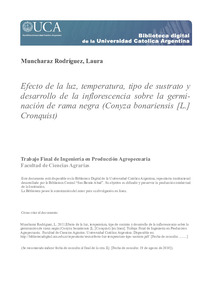Por favor, use este identificador para citar o enlazar este ítem:
https://repositorio.uca.edu.ar/handle/123456789/300| Título: | Efecto de la luz, temperatura, tipo de sustrato y desarrollo de la inflorescencia sobre la germinación de rama negra (Conyza bonariensis [L.] Cronquist) | Autor: | Muncharaz Rodríguez, Laura | Director de Tesis: | Zapiola, María Luz | Palabras clave: | CONYZA BONARIENSIS; MALEZAS; ECOLOGIA; GERMINACION; SEMILLA; DORMICION; CLIMATOLOGIA; ENSAYO; ESCARDA | Fecha de publicación: | 2011 | Cita: | Muncharaz Rodríguez, L. 2011.Efecto de la luz, temperatura, tipo de sustrato y desarrollo de la inflorescencia sobre la germinación de rama negra (Conyza bonariensis [L.] Conquist) [en línea]. Trabajo Final de Ingeniería en Producción Agropecuaria. Facultad de Ciencias Agrarias. Universidad Católica Argentina. Disponible en: https://repositorio.uca.edu.ar/handle/123456789/300 | Resumen: | Resumen: Conyza bonariensis [L.] Cronquist es una maleza muy extendida en Argentina que en los últimos años ha originado problemas en su control con las técnica habituales. El hecho de tener que modificar las técnicas de control, lleva sin duda a un conocimiento previo de la ecología de esta maleza. El objetivo fue evaluar la respuesta de germinación de semillas de C. bonariensis a distintas combinaciones de factores que afectan a este proceso como son: la madurez de semillas (factor intrínseco), la temperatura y la iluminación (factores extrínsecos). Así como evaluar la existencia de dormición sobre las semillas en función de su respuesta al KNO3. En un primer ensayo se pusieron a prueba la influencia de dos temperaturas (continua a 20º y alternadas a 30-15ºC) con y sin presencia de luz, en sustrato de H2O o KNO3. Se estudió el Porcentaje de Germinación (PG), la Velocidad Media de Germinación (VMG) y el Tiempo Medio de Germinación (TMG). En el segundo ensayo se estudió el PG en función del desarrollo que presentaban los capítulo florales (A, B y C) y la ubicación de las semillas sobre el receptáculo (centro y perímetro) en régimen lumínico y con temperaturas de 30- 15ºC. Del primer ensayo resultaron significativos el factor luz, que favoreció la germinación, además de su interacción con la temperatura, donde a 20ºC en oscuridad se obtuvo la misma respuesta de germinación que en el régimen lumínico independientemente de la temperatura. Se demostró que, para el proceso de germinación, la luz es condición suficiente, pero que en ausencia de luz la temperatura pasa a ser el factor decisivo en la germinación. El KNO3 aceleró significativamente el proceso de germinación, al afectar la VMG y el TMG, evidenciando una latencia débil de las semillas. En el segundo ensayo se determinó que el potencial germinativo variaba en función del desarrollo del capítulo floral y la ubicación de la semillas sobre el receptáculo, siendo las semillas del centro, sobre capítulos tipo C, las que tuvieron PG más altos. Relacionar el desarrollo del capítulo floral con el momento de desmalezado puede dar una idea de la contribución que se esta haciendo al banco de semillas del suelo. Abstract: The Conyza bonariensis [L.] Cronquist is a very extended weed in Argentina which in the last years has arisen problems to its control with the usual techniques. The fact of changing the usual control techniques leads, clearly, to a prior knowledge of the ecology of this weed. The aim was to understand the germination reply of C. bonariensis seeds to different combinations of factors that can affect this process, like the ripeness of the seeds (intrinsic factor), the temperature and the lighting (external factors). This work also evaluates the existence of dormancy in the seeds according to their reply to KNO3. A first test examined the influence of two different types of temperature (constant at 20ºC and alternated between 30ºC-15ºC), with and without the presence of light, in a substratum of H3O or KNO3. This trial studied the Germination Percentage (PG), the Average Germination Rate (VMG) and the Average Germination Time (TMG). A second test studied the GP according to the development of the inflorescence (A, B, C) and the position of the seeds in the receptacle (middle and perimeter) with light and alternated temperature between 30ºC-15ºC. In the first test was significant the light factor, which benefited the germination, as well as the interaction with the temperature. The same germination reply was obtained at 20ºC in darkness and in light regardless of the temperature. It was proved that, for the germination process, light is a self condition but in light absence the temperature is the key factor for the germination. The KNO3 considerably accelerated the germination process affecting the VMG and the TMG, revealing a weak latency of the seeds. The second test determined that the germination potential varied depending on the development of the inflorescence and the position of the seeds in the receptacle, being the ones in the middle, among the C type inflorescences, the ones that remarkably had higher PG. Considering the development of the inflorescence when weeding can help to make an idea of the contribution that is being made to the seed bank in the ground. |
URI: | https://repositorio.uca.edu.ar/handle/123456789/300 | Disciplina: | CIENCIAS AGRARIAS | Derechos: | Acceso Abierto |
| Aparece en las colecciones: | Trabajo Final de Ingeniería en Producción Agropecuaria |
Ficheros en este ítem:
| Fichero | Descripción | Tamaño | Formato | |
|---|---|---|---|---|
| doc.pdf | 1,4 MB | Adobe PDF |  Visualizar/Abrir |
Visualizaciones de página(s)
414
comprobado en 30-abr-2024
Descarga(s)
275
comprobado en 30-abr-2024
Google ScholarTM
Ver en Google Scholar
Este ítem está sujeto a una Licencia Creative Commons

